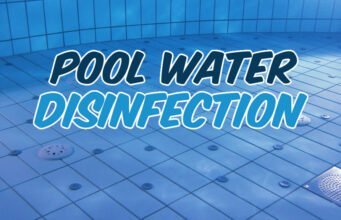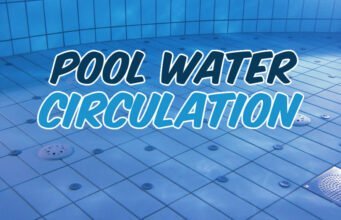When it comes to cleaning pool water, the filtration system is responsible for the hardest job, but it is up to the chemical treatment to do a more refined work.
It is important to carefully manipulate the chemical balance of a pool for several reasons:
– Proliferation prevention of dangerous pathogens, such as bacteria, that are present in the water. A swimming pool filled with untreated water can be a perfect place for disease-causing microorganisms to contaminate people;
– Water with the wrong chemical balance can damage several parts of a swimming pool;
– Water with improper balance can irritate the skin and the eyes of swimmers;
– The improper balance can easily make the water become cloudy.
To eliminate these pathogens in the pool water, a disinfectant must be used; the most popular one is chlorine in the form of chemical compounds, such as calcium hypochlorite (a solid solution) or sodium hypochlorite (a liquid solution).
Pool chemistry
When the chlorinated compound is added to water, the hypochlorite reacts forming several chemical species, most notably the hypochlorous acid.
 The hypochlorous acid kills bacteria and other pathogens, attacking lipids in the cell wall, and, through an oxidation reaction, it destroys enzymes and structures within the cell.
The hypochlorous acid kills bacteria and other pathogens, attacking lipids in the cell wall, and, through an oxidation reaction, it destroys enzymes and structures within the cell.
Alternative compounds, like bromite, basically do the same thing, but with slightly different results.
Hypochlorite is usually prepared in form of a liquid, powder or tablet (although some professionals use chlorine gas) and it can be added to the water during the cycle.
Pool experts generally recommend this inclusion after the filtration process using a chemical feeder.
If added directly to the pool by using tablets in the skimmer boxes, the hypochlorite will tend to concentrate in those areas.
One problem with hypochlorous acid is that it is not particularly stable.
It can degrade when exposed to the sun’s ultraviolet light and combine with other chemical elements to form new compounds.
 Pool chlorinators often include a stabilizing agent, such as cyanuric acid. The cyanuric acid reacts with chlorine compound to form an even more stable compound that does not degrade so easily when exposed to the ultraviolet rays.
Pool chlorinators often include a stabilizing agent, such as cyanuric acid. The cyanuric acid reacts with chlorine compound to form an even more stable compound that does not degrade so easily when exposed to the ultraviolet rays.
Even with a stabilizing agent, the hypochlorous acid can combine with other elements, forming compounds that are not as effective.
For example, the hypochlorous acid can combine with ammonia found in urine, among other substances, to produce several chloramines.
Chloramines are not only weak disinfectants but can irritate your skin and eyes, also leaving a strong chlorine smell in the pool.
The typical smell and eye irritation associated with swimming pools are in fact due to chloramines, and not to the common hypochlorous acid.
A strong smell usually means that there is a small quantity of free chlorine (hypochlorous acid).
To eliminate chloramines, it is necessary to do a shock treatment in the pool: add a strong dosage of disinfectant, whichever it is, to remove organic matter and harmful chemical compounds.
We have explained in detail what to do to end the strong smell of chlorine in the pool in a previous article.
The chloramine formation is related to the second largest element of the pool chemical composition, the pH.
PH Level
The water pH is a measure of its total balance (acid-alkaline), which is the relative proportion of acids and bases in the water.
Check out our article regarding the importance of controlling the pool’s pH to learn more about it!
If you let the water become too acidic or too alkaline, you will certainly get undesirable results with your pool.
If the pool water is too acid, the metal parts of the pool tend to be corroded when in contact with the water, and it can also cause skin and eye irritation on the people that swim in it.
If the water is too alkaline, or basic, it can cause calcium accumulation on the pool or the equipment surfaces. Additionally, it makes the water more dense and prone to be milky, whitish and opaque.
Read more about opaque and milky pool water.
The high acidity or alkalinity of the water alters the chlorine effectiveness! When the water is too alkaline, it will not destroy the pathogens, and if the water is too acidic, it dissipates much faster.
On the pH scale, zero means extreme acidity, 14 is extreme alkalinity and 7 means a neutral state. Most pool experts recommend the pH to be between 7.2 and 7.8.
To change the pH, acid or alkali elements must be added to the pool water.
The use of sodium carbonate will increase the pool’s pH and the usage of muriatic acid will decrease the pool’s pH.
The pool chemical balance maintenance is a continuous process, since any new element, such as tanning oils, rain, impurities in general and other substances that could eventually fall in the water, alters the entire water chemical composition.
Besides the pool’s pH, it is of course also necessary to monitor the total alkalinity and the water hardness and chlorine!
Alkalinity level
Alkalinity can be defined as the pool’s ability to neutralize acids, and consequently maintain its pH stability.
It is a capacity parameter and not an intensity one (such as pH).
This explains why pools have a neutral pH and still have high or low alkalinity.
The alkalinity is primarily due to carbonates and bicarbonates and, secondarily, to hydroxide ions, silicates, borates, phosphates and ammonia.
Why controlling the pool alkalinity
Well, here at PoolPiscina.com we always say that before putting chlorine or any other chemical in the pool, it is essential to adjust the water’s pH and alkalinity.
Although all the parameters influence the water chemical balance and people’s comfort while swimming, special attention should be paid to alkalinity too. When alkalinity is kept in an ideal range, it provides pH stability, eliminating corrections and, therefore, generating savings and greater practicality.
 Alkalinity is defined as the number of substances present in the water that are capable of neutralizing acids.
Alkalinity is defined as the number of substances present in the water that are capable of neutralizing acids.
In other words, alkalinity acts as a pH buffer, preventing variations. It is measured in ppm (parts per million) and the ideal for a pool is to keep it between the 80 and the 120 ppm.
The alkalinity analysis can be performed using an Alkalinity Test Kit or with the Test Tape.
We highly recommend checking both the pH and the alkalinity with the test kit, as it has a much higher accuracy than the Tape!
Bottom line: alkalinity must be controlled to have a stable pH!
Read more about these parameters in the following texts:
- The importance of pool pH control
- The importance of controlling the pool alkalinity
- Controlling the pool pH and alkalinity – Advanced
When considering all the chemical composition and machinery involved in swimming pools, it is clear that these are really impressive technologies. It takes a lot of work to build and maintain them.
The best thing to do is to leave the pool maintenance to a company qualified for it.
We hope you enjoyed learning a little more about pool chemistry!
If you have any doubts, use the comments to contact us!
To keep following our content, add our site to your bookmarks and if you spread the word, share it with your friends!










